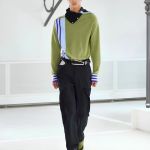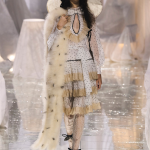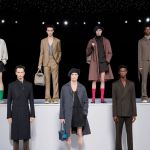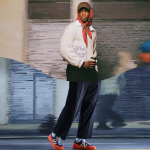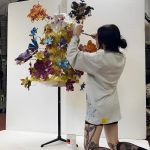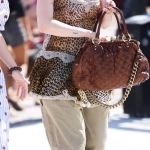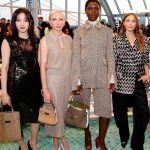
Product placement starts from the front row
When a banner in Times Square is not enough
October 3rd, 2024
Who knows if Michelle Williams, Jodie Turner Smith, and Elizabeth Olsen expected to find themselves in the front row wearing the exact same shoes as their colleagues. A few years ago, this kind of situation might have caused embarrassment, or perhaps some amusement – like when, in Sex & the City, Samantha Jones shows up on the red carpet in the same dress as Hannah Montana – but nowadays, it just smells like product placement. For a while now, brands have been using celebrities at fashion shows to advertise their clothes, dressing them head to toe in items from the brand’s latest collection, while the new one debuts on the runway just a few feet away. If the phenomenon of the Miu Miu miniskirt has taught us anything, it’s that luxury brands have learned how to do advertising: aware that today’s trends come and go like Wall Street investments, they multiply product placements in the front row hoping it will land on consumers’ screens more than once – a case of, even if you shoot randomly, you’ll hit the target eventually if you shoot enough. And so it happened again at the latest Tory Burch show, where the brand invited Williams, King, and Olsen to New York Fashion Week and sat them all together, all wearing the same shoes, the Pierced Pump. Along with Mindy Kaling, Joey King, and Ella Emhoff, twelve feet were dressed in metallic-insert heels, starring in countless photos that now accompany articles with headlines like “The New It-Shoe of the Season”. It may seem easy for the press and brands to proclaim a new accessory as the top item for the season change, but they often forget that the customers are the ones who choose an it-item when they vote with their money.
Last February, while the first collection by new creative director Chemena Kamali was being presented on the runway at the FW24 Chloé show, a row of wooden clogs appeared in the front row. From the queen of boho chic Sienna Miller to Georgia May Jagger (daughter of Mick Jagger and Jerry Hall, also present at the show), numerous celebrities sported the maison's new footwear. In that case too, it would be interesting to know if anyone felt disappointed seeing an accessory from their look, which was likely meticulously planned during fittings and tailoring meetings in the days leading up to the show, replicated countless times. Moreover, the marketing move was not very profitable: according to Trendalytics results, “wedge heels” saw a +235% increase in searches online after the Chloé show, but a week later it had already faded into Google’s depths – confirming the thesis, at the latest show, the brand chose not to repeat the trick, allowing guests to wear different shoes.
@nssmagazine What would you do if you could spend a day with the one and only Miuccia Prada? @Miu Miu #miumiu #tiktokfashion #fashiontikok #guest #celeb #miucciaprada #parisfashionweek #pfw #interview #fashioninterview #fashionshow #camilacabello #minniemiumiu #reignjudge original sound - nss magazine
While showing “a lot of everything” might seem like the right choice for a brand that wants to project its items to the top of shopping rankings, the results tell a different story. In the latest rankings of Lyst, an app for selling luxury goods and a search platform, the hottest products of the first two quarters of 2024 all had to do with functionality, rather than advertising, such as Cos fisherman sandals, Loewe x On running shoes, Miu Miu x New Balance sneakers, or the Carhartt workwear jacket. Considering that luxury is rooted in exclusivity, it becomes difficult to understand how spreading an item across numerous covers and just as many celebrities enhances its desirability. In high fashion, rarity is rewarded, so even too much marketing, in the long run, can turn into poison. The only exception is Margiela's Tabi shoes, which, already being an it-shoe for some time, only benefited from the viral surge they experienced this year after the TikTok incident. Certainly, modern consumers enjoy observing trends, reflecting them in their tastes, and following the aesthetics launched by brands, but even if they sometimes push it to the limit, becoming a ready-to-use stereotype, they will always prefer to believe the idea came from their own minds. Or at least, that it seems so.










